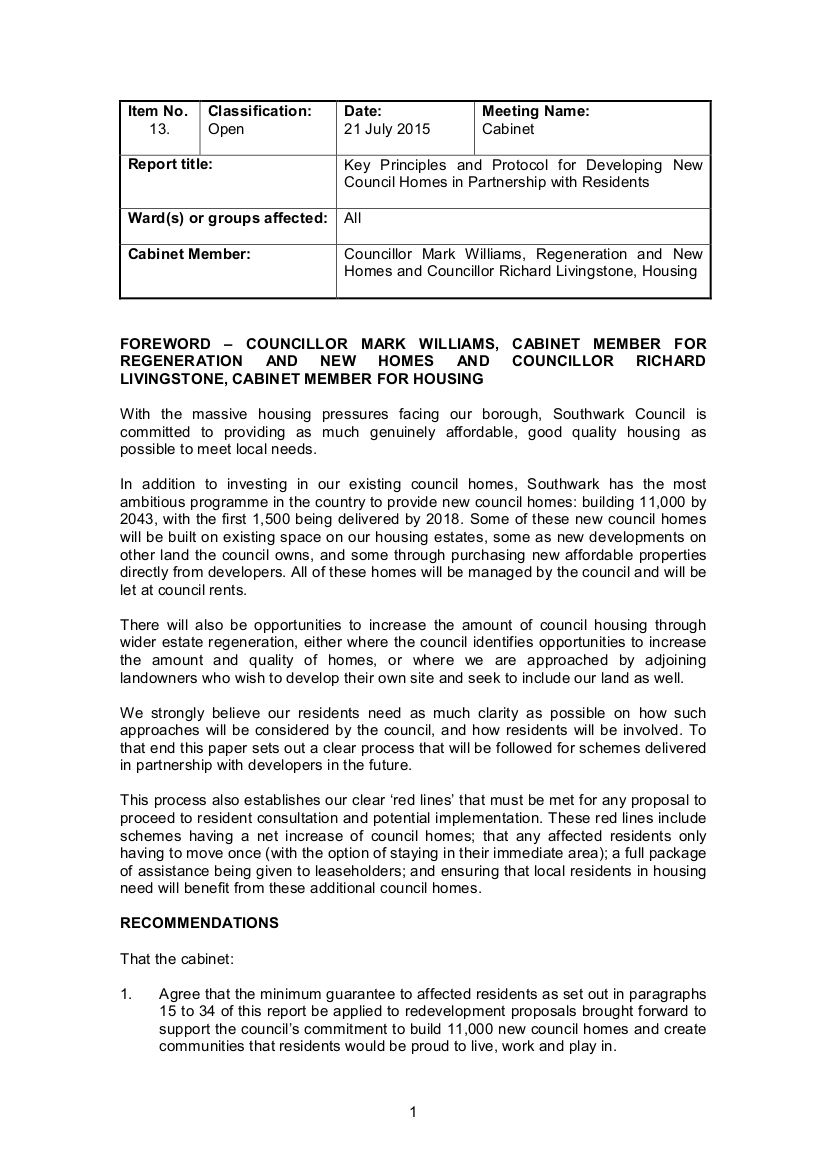Last week the Guardian picked up on our analysis of the Neo Bankside affordable housing fiasco and ran an article highlighting Southwark’s growing problem of accepting payments in-lieu of affordable housing.
On Thursday the Guardian ran a different story about an in-fill project to provide new council homes on a Southwark council estate, which it said “shows London the way” in solving the housing crisis.
As part of its programme to build 11,000 new council homes, Southwark council is trumpeting the construction of 30 new council homes on the Kipling estate, managed by its TMO ‘Leathermarket CBS’.
 Proposed site for new council homes on the TMO-managed Kipling estate
Proposed site for new council homes on the TMO-managed Kipling estate
But what the Guardian article or press release didn’t say, is that the project is being funded by the developer of a new residential tower at London Bridge, who has agreed to fund it in exchange for not having to provide any affordable housing on-site in its development.
Developer ‘Investream’- acting under the auspices of a shell company ‘Bilford Ltd’ (registered in Jersey) - has submitted a planning application for the demolition of Capital House (a 10 storey building leased by KCL as part of its Guy’s campus) and the construction of ‘The Quill’ - a 21 and 31 storey building connected via walkways and decorated with a quill-shaped spire, which the architect claims “will draw on the literary connections of Southwark.” (para. 4.132)
 CGI mockup of proposed development ‘The Quill’ near London Bridge
CGI mockup of proposed development ‘The Quill’ near London Bridge
The Quill was orginally granted planning consent in 2011, but to provide student accommodation which was exempt from affordable housing requirements. This new application seeks to convert the accommodation to private residential use, providing 119 new homes. Southwark’s 35% policy would normally require at least 41 of these to be provided as affordable housing units on-site, of which 13 would need to be shared ownership and 28 social rented. Instead of meeting these on-site requirements, Bilford has applied to fund the construction of around 30 social rented homes off-site on the Kipling estate.
In November 2014 Bilford submitted a detailed Affordable Housing Statement with its planning application, setting out its funding offer to Leathermarket and has submitted a confidential viability assessment justifying why affordable housing on-site would not be viable.
 Extract from The Quill planning application’s affordable housing statement
Extract from The Quill planning application’s affordable housing statement
Things have apparently now changed since this original agreement between Bilford and Leathermarket. Bilford will now be making the in-lieu payment to the council’s s106 fund instead of directly to Leathermarket. The council will in turn fund the Kipling estate project from its pooled S106 funds. This triangular accounting provides a layer of separation between the two schemes and enables Southwark to trumpet the Kipling project as part of its ambitious programme to build 11,000 new council homes.
New social rented homes are good, but accepting them in-lieu of ones that should be provided on-site in new developments goes directly against the council’s policy of creating mixed communities, which it has used so vociferously in justifying the demoliton of its ‘mono-tenure’ Heygate & Aylesbury estates.
 Kim Humphries acting on behalf of BilfordRepresenting and advising Bilford is former deputy council leader, turned development consultant Kim Humphries. Kim founded ‘Carvil Ventures’ after losing his seat in 2010 and has been helping developers obtain planning permission ever since. Among his clients are Delancey, developers of the Elephant & Castle shopping centre and 185 Park Street; Neobrand’s 87 Newington Causeway development and British Land’s Canada Water scheme.
Kim Humphries acting on behalf of BilfordRepresenting and advising Bilford is former deputy council leader, turned development consultant Kim Humphries. Kim founded ‘Carvil Ventures’ after losing his seat in 2010 and has been helping developers obtain planning permission ever since. Among his clients are Delancey, developers of the Elephant & Castle shopping centre and 185 Park Street; Neobrand’s 87 Newington Causeway development and British Land’s Canada Water scheme.
Kim also prepared Bilford’s Statement of Community Involvement - a necessary planning document showing that the developer has consulted with the local community. Kim claims to have obtained “extensive feedback” from his public consultation, in which he claims “considerable support was expressed for Bilford’s redevelopment plans with 60% supporting the proposals.” But page 15 of the Statement, shows that his claim of 60% support is based on a survey of just 15 people..
The future of “high investment needs estates”
Last week we blogged about the results of Savills’ “Asset Performance Evaluation,” which gave rankings to each of the borough’s council estates based on asset value and social achievement indicators. The estates were then labelled as either assets which would continue to receive “regular investment” or _ “high investment needs estates,”_ which would be considered for _ “redevelopment or regeneration”_ .
 Cllr Richard Livingstone - Member for HousingWhen Southwark News ran a story on the Savills evaluation last week, Cllr Richard Livingstone fought back insisting that it had been misunderstood and reassured council tenants that it was “only ever an exercise to see how the council could invest its funds in an informed way, to improve everyone’s living conditions.”
Cllr Richard Livingstone - Member for HousingWhen Southwark News ran a story on the Savills evaluation last week, Cllr Richard Livingstone fought back insisting that it had been misunderstood and reassured council tenants that it was “only ever an exercise to see how the council could invest its funds in an informed way, to improve everyone’s living conditions.”
He claimed that it was simply “an indication of where higher levels of investment are needed in the buildings alone, to make sure they are up to the standards of quality our residents deserve.“
He goes on to explain that “The report makes it very clear that there is no need for Southwark to consider any further large scale redevelopment schemes like the Heygate or the Aylesbury and that any redevelopment would only be considered as a ‘last resort.”
However, a closer look at Cllr Livingstone’s report which accompanied the Savills evaluation, paints a very different picture of its purpose and intent:
 Cllr Livingstone’s report to CabinetThe report speaks of “high investment need estates” where there is “a legacy of poorly designed and built housing,” coupled with “opportunities to increase the amount of council housing through wider estate regeneration.”
Cllr Livingstone’s report to CabinetThe report speaks of “high investment need estates” where there is “a legacy of poorly designed and built housing,” coupled with “opportunities to increase the amount of council housing through wider estate regeneration.”
It goes on to highlight “the need to make difficult choices” accompanied by “the prospect of leveraging in private sector investment,” but with the reassurance that “the number of new council homes delivered as a result of the schemes will exceed the numbers demolished.”
The report concludes by saying that residents in those estates affected will only be consulted once officers have decided their homes should be demolished: “Prior to proceeding to engagement with residents, a cross-council panel of relevant officers will have met to establish the feasibility of sites.” (para. 18)
We blogged in July last year about a council report which referred to a zone “within which the majority of housing estates identified for Estate renewal are located” and in December last year about the commissioning of the asset performance evaluation. Two weeks ago the council leader claimed to “have identified approximately 500 sites” for its programme to build 11,000 homes (see Q4).
The council should stop beating about the bush with its estate renewal plans. The fate of the Heygate, Aylesbury, Wood Dene and Elmington estates were all sealed when they became labelled as “high investment needs estates.” The council needs to come clean about exactly what plans it has for the earmarked estates and start involving residents in its decision making now.
 The ‘Staying Put’ HandbookSouthwark News has published a list of all the “high investment need estates” earmarked by the Savills evaluation. Residents on these estates would do well to start reading the ‘Staying Put Handbook’ - a guide for communities facing demolition and displacement.
The ‘Staying Put’ HandbookSouthwark News has published a list of all the “high investment need estates” earmarked by the Savills evaluation. Residents on these estates would do well to start reading the ‘Staying Put Handbook’ - a guide for communities facing demolition and displacement.
